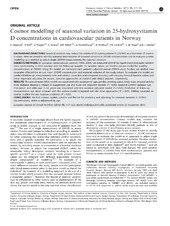| dc.contributor.author | Degerud, Eirik Magnus Meek | en_US |
| dc.contributor.author | Hoff, Rune | en_US |
| dc.contributor.author | Nygård, Ottar | en_US |
| dc.contributor.author | Strand, Elin | en_US |
| dc.contributor.author | Nilsen, Dennis W. T. | en_US |
| dc.contributor.author | Nordrehaug, Jan Erik | en_US |
| dc.contributor.author | Midttun, Øivind | en_US |
| dc.contributor.author | Ueland, Per Magne | en_US |
| dc.contributor.author | De Vogel, Stefan | en_US |
| dc.contributor.author | Dierkes, Jutta | en_US |
| dc.date.accessioned | 2016-09-02T11:46:54Z | |
| dc.date.available | 2016-09-02T11:46:54Z | |
| dc.date.issued | 2016 | |
| dc.identifier.issn | 0954-3007 | |
| dc.identifier.uri | https://hdl.handle.net/1956/12717 | |
| dc.description.abstract | Background/Objectives: Seasonal variation may reduce the validity of 25-hydroxyvitamin D (25OHD) as a biomarker of vitamin D status. Here we aimed to identify potential determinants of seasonal variation in 25OHD concentrations and to evaluate cosinor modelling as a method to adjust single 25OHD measurements for seasonal variation. Subjects/Methods: In Caucasian cardiovascular patients (1999–2004), we measured 25OHD by liquid chromatography tandem mass spectrometry in 4116 baseline and 528 follow-up samples. To baseline values, we fitted a cosinor model for monthly concentrations of 25OHD. Using the model, we estimated each patient’s adjusted annual 25OHD value. Further, we studied how covariates affected the annual mean 25OHD concentration and seasonal variation of the study cohort. To evaluate the model, we predicted follow-up measurements with and without covariates and compared accuracy with carrying forward baseline values and linear regression adjusting for season, common approaches in research and clinical practice, respectively. Results: The annual mean (59.6 nmol/l) was associated with participants’ age, gender, smoking status, body mass, physical activity level, diabetes diagnosis, vitamin D supplement use and study site (adjusted models, P<0.05). Seasonal 25OHD variation was 15.8 nmol/l, and older age (>62 years) was associated with less variation (adjusted model, P=0.025). Prediction of follow-up measurements was more accurate with the cosinor model compared with the other approaches (P<0.05). Adding covariates to cosinor models did not improve prediction (P>0.05). Conclusions: We find cosinor models suitable and flexible for analysing and adjusting for seasonal variation in 25OHD concentrations, which is influenced by age. | en_US |
| dc.language.iso | eng | eng |
| dc.publisher | Nature Publishing Group | eng |
| dc.relation.ispartof | <a href="http://hdl.handle.net/1956/12732" target="blank">Vitamin D status and cardiovascular disease. Observational studies in patients who underwent coronary angiography</a> | |
| dc.rights | Attribution CC BY | eng |
| dc.rights.uri | http://creativecommons.org/licenses/by/4.0/ | eng |
| dc.title | Cosinor modelling of seasonal variation in 25-hydroxyvitamin D concentrations in cardiovascular patients in Norway | en_US |
| dc.type | Peer reviewed | |
| dc.type | Journal article | |
| dc.description.version | publishedVersion | en_US |
| dc.rights.holder | Copyright 2016 Macmillan Publisher Limited | |
| dc.identifier.doi | https://doi.org/10.1038/ejcn.2015.200 | |
| dc.identifier.cristin | 1329162 | |
| dc.source.journal | European Journal of Clinical Nutrition | |
| dc.source.40 | 70 | |
| dc.source.14 | 4 | |
| dc.source.pagenumber | 517-522 | |

